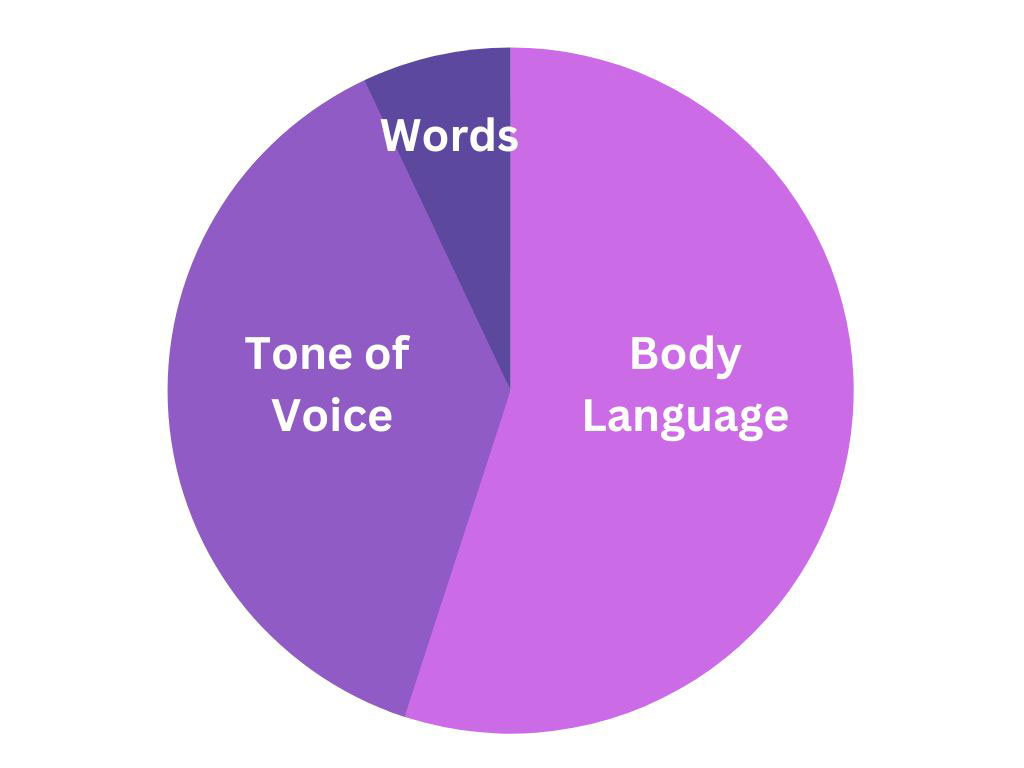Thirty years ago, I learned about the communication pie and it forever changed the way I think about communication. The concept was put forth by a college professor, Albert Mehrabian, in the 1970’s.

When it comes to communicating feelings and attitudes, words, tone of voice, and body language all contribute to messaging. It may surprise you to learn that words have the lowest impact on understanding at only 7%. Tone comes in second at 38%.
The most impact on what we understand from a conversation comes from body language – non-verbal communication. What we don’t say speaks louder than words, through our facial expressions, gestures and body positioning. More than half of what we convey to others is influenced by non-verbal cues.
Let’s explore some of the implications of these statistics so we can improve the way we communicate in any relationship (including sales!).
Should I write, call, or set up a meeting?
It’s easy to talk or write a note, yet not so easy to convey exactly what you are trying to say. Here are some practical guidelines on when to write, and when to speak with someone that will improve the quality of your communication.
When to write:
Written communication is preferable when you have facts, dates, details, or other agreed deliverables to convey. Writing things out creates a checklist of sorts that helps everyone review, validate, and respond. You can enhance emails, letters and messaging by presenting information in a logical order with clear, concise language. Think from the reader’s perspective and include information in a way that they would want to receive it. Choose your written words and style to create a warm, friendly tone.
One of the benefits of written communication is that people are free to respond at their convenience. So if you need answers immediately, it’s helpful to follow up your note with a call or text advising the recipient that the email needs their immediate attention. Even include the words “Action Needed” in the title to alert someone that you need to hear back from them.
When to speak by phone or face to face:
Because communication is complex, many situations require dialogue to gain consensus or accomplish desired outcomes. Dialogue implies a dynamic, real-time idea exchange with questions and answers flowing freely. This is hard (maybe impossible?) to replicate with the written word alone. In a phone call, you add tone of voice to the words you speak, while video calls or in-person meetings add tone and body language to the words used.
Connect by phone, video chat or in person when you want to communicate ideas, values, beliefs, and emotions.
Also, whenever there is a potential for a negative reaction, it is wise to dialogue so any ill feelings can be addressed and resolved quickly. You’ll be able to see reactions in someone’s body language that they would never verbalize. If you see discomfort, address it gently, with appropriate care and concern.
Combine written and verbal communication:
Consider using both forms of communicating. In some cases it will be beneficial to start in writing and scheduling a follow up meeting. In others the meeting may come first and a recap and next steps are delivered in writing to keep the conversation moving forward.
Bottom line…
Whenever you can use all three pieces of the communication pie you have greater success communicating your intentions and understanding others’. Thanks for listening (reading). If you’d like to chat about anything sales or communications related, reply to this email and we’ll set up a time to chat.
